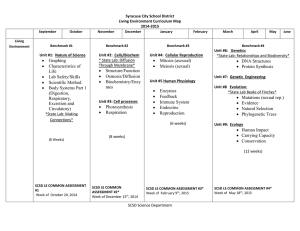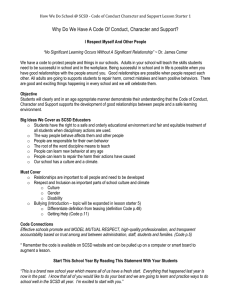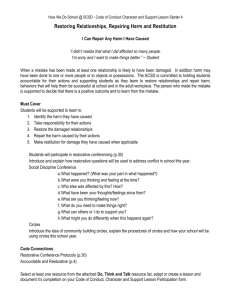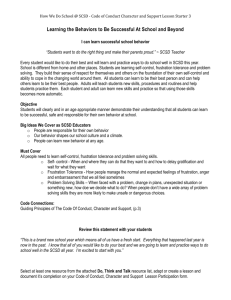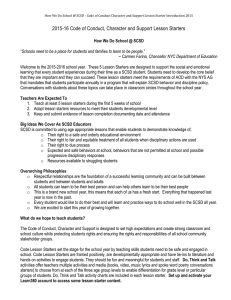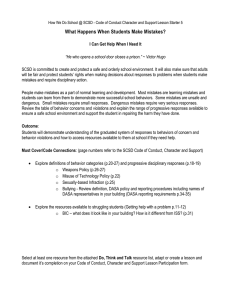Student Rights and Responsibilities
advertisement
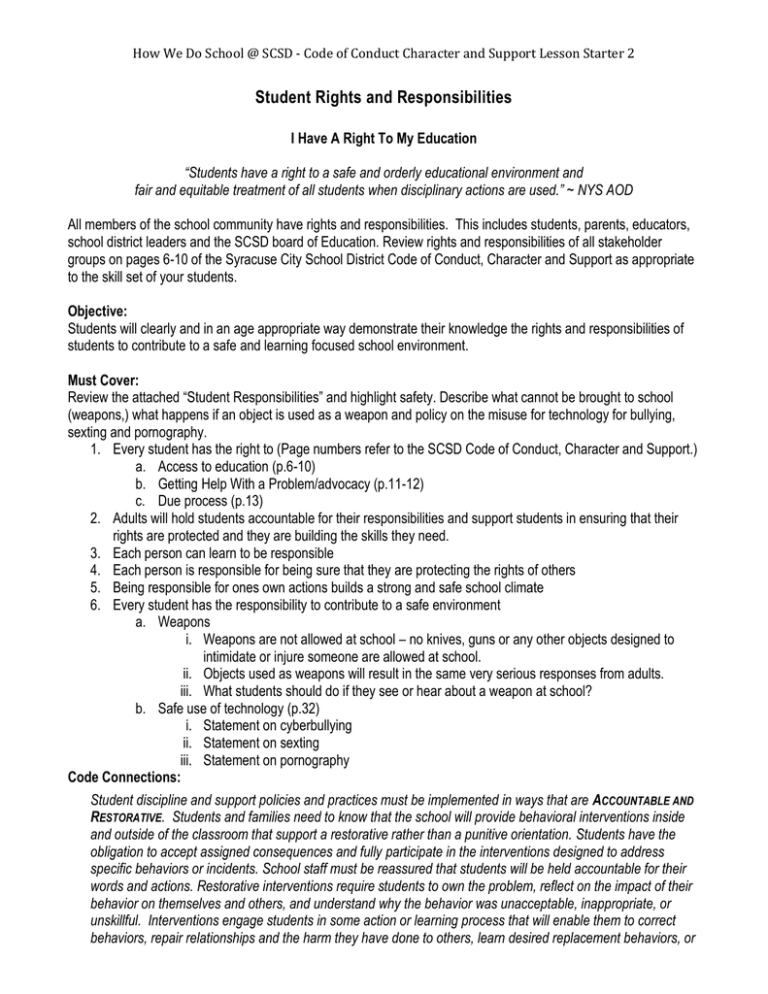
How We Do School @ SCSD - Code of Conduct Character and Support Lesson Starter 2 Student Rights and Responsibilities I Have A Right To My Education “Students have a right to a safe and orderly educational environment and fair and equitable treatment of all students when disciplinary actions are used.” ~ NYS AOD All members of the school community have rights and responsibilities. This includes students, parents, educators, school district leaders and the SCSD board of Education. Review rights and responsibilities of all stakeholder groups on pages 6-10 of the Syracuse City School District Code of Conduct, Character and Support as appropriate to the skill set of your students. Objective: Students will clearly and in an age appropriate way demonstrate their knowledge the rights and responsibilities of students to contribute to a safe and learning focused school environment. Must Cover: Review the attached “Student Responsibilities” and highlight safety. Describe what cannot be brought to school (weapons,) what happens if an object is used as a weapon and policy on the misuse for technology for bullying, sexting and pornography. 1. Every student has the right to (Page numbers refer to the SCSD Code of Conduct, Character and Support.) a. Access to education (p.6-10) b. Getting Help With a Problem/advocacy (p.11-12) c. Due process (p.13) 2. Adults will hold students accountable for their responsibilities and support students in ensuring that their rights are protected and they are building the skills they need. 3. Each person can learn to be responsible 4. Each person is responsible for being sure that they are protecting the rights of others 5. Being responsible for ones own actions builds a strong and safe school climate 6. Every student has the responsibility to contribute to a safe environment a. Weapons i. Weapons are not allowed at school – no knives, guns or any other objects designed to intimidate or injure someone are allowed at school. ii. Objects used as weapons will result in the same very serious responses from adults. iii. What students should do if they see or hear about a weapon at school? b. Safe use of technology (p.32) i. Statement on cyberbullying ii. Statement on sexting iii. Statement on pornography Code Connections: Student discipline and support policies and practices must be implemented in ways that are ACCOUNTABLE AND RESTORATIVE. Students and families need to know that the school will provide behavioral interventions inside and outside of the classroom that support a restorative rather than a punitive orientation. Students have the obligation to accept assigned consequences and fully participate in the interventions designed to address specific behaviors or incidents. School staff must be reassured that students will be held accountable for their words and actions. Restorative interventions require students to own the problem, reflect on the impact of their behavior on themselves and others, and understand why the behavior was unacceptable, inappropriate, or unskillful. Interventions engage students in some action or learning process that will enable them to correct behaviors, repair relationships and the harm they have done to others, learn desired replacement behaviors, or How We Do School @ SCSD - Code of Conduct Character and Support Lesson Starter 2 restore their good standing. (p.4) Select at least one resource from the attached Do, Think and Talk resource list, adapt or create a lesson and document it’s completion on your Code of Conduct, Character and Support Lesson Participation form. Do, Think and Talk ~ Questions and Conversation Starting Activities Pre K-2 Grades 3-5 6-8 9-10 11-12 Activity: Conversation Starter Questions and Quotes Q. What are rights? How are they different at home and school? Q. What are responsibilities? How are they different at home and school? Q. What would be considered a weapon? What should students do if they see or hear about a weapon at school? “We have a Bill of Rights, what we need is a Bill of Responsibilities.” Bill Maher “Every right implies a responsibility, every opportunity and obligation, every possession a duty.” John D. Rockefeller See Due Process Lessons Resources from American Bar Association – see resource list Interactive Computer Resource: Pebble Go Responsiblities Literature: My Secret Bully – Trudy Ludwig – guided discussion questions at text end Slim Goodbody’s Due Process of Public School http://www.learn360.com/Show Video.aspx?lid=10388216&Sea rchText=due+process&ID=224 147 Slim Goodbody’s Due Process of Law http://www.learn360.com/Show Video.aspx?lid=10388216&Sea rchText=due+process&ID=224 146 Consider the broad range of lesson suggestions about citizenship and responsibility at http://www.middleweb.com/24552/using-dystopian-fiction-to-explore-citizenship/ Interactive Computer Resource: Cyber-bullying https://www.dosomething.org/facts/11-facts-about-cyber-bullying Activity: Re-Code the Code Explain “It’s Your Responsibility” using media (write a PSA, make a poster, make a flyer, write a skit) to explain rights and responsibilities to a 3rd grader, ELL family or other audience. Video: Cyber-bullying http://www.netsmartz.o rg/RealLifeStories/Can tTakeItBack How We Do School @ SCSD - Code of Conduct Character and Support Lesson Starter 2 Pre K-2 Grades 3-5 6-8 9-10 11-12 Lesson Plan: Due Process http://www.americanba r.org/groups/public_ed ucation/resources/less on-plans/middleschool/dueprocess.html Activity: Re-Code the Code Demonstrate Due Process using media (write, cartoon, vine, video, PSA…) so that a third grader or an ELL family member will understand the process. Film: Bully http://www.thebullyproject.com/ Classroom Teachers are required to keep evidence of having covered the 5 attached lesson starters with each student. Record the date, material covered and attendance of all lessons to meet the legal requirements of the AOD. Resources Printable quotes that support positive school culture and personal accountability http://www.technologyrocksseriously.com/p/school-signs.html - .VdvM-NNVikp http://www.americanbar.org/content/dam/aba/images/public_education/lesson_plans/middle_school/itsMyLife.pdf How We Do School @ SCSD - Code of Conduct Character and Support Lesson Starter 2 Student Responsibilities and Expected Behaviors It’s your responsibility! PERSONAL CONDUCT & CHARACTER COOPERATING WITH OTHERS AND TREATING OTHERS WITH RESPECT Attending school regularly and on time. Accepting direction, requests, feedback, and support respectfully from adults. Demonstrating self-discipline by making responsible behavior and academic choices. Being truthful about and accountable for your words and actions. Following school rules and meeting standards of behavior in the Code of Conduct, Character, and Support Accepting consequences when behavioral expectations are not met or school rules are violated. Making effort to correct and improve behavior through assigned interventions. Dressing appropriately. LEARNING Completing high quality work in every subject. Being prepared to learn. Challenging yourself and making your best effort. Demonstrating a strong work ethic. Bringing an open mind and positive attitude to learning every day. Seeking help and assistance when you need it. Treating others the way they want to be treated. Expressing your thoughts and opinions in ways that are polite, respectful, and courteous. Using a considerate tone of voice and appropriate body language. Listening when others are speaking to you. Respecting other’s personal space and keeping your hands to yourself. Working with others cooperatively in large and small groups. Acting with kindness, caring, and sensitivity toward others. PROPERTY OF OTHERS Taking care of property that belongs to other students, adults, or the school. Using school or other people’s materials carefully for the intended purpose. Keeping personal electronic devices off and out of sight except with permission of school staff. Using school technology appropriately as directed by adults. SAFE SCHOOL COMMUNITY Helping to make school a community free from violence, intimidation, bullying, harassment, and discrimination. Asking for assistance when you need help resolving conflicts and differences. Contributing to the safety and well being of our community. Using all equipment in schools and on buses in a safe manner. Putting everyone’s safety first by NOT engaging in violent or destructive acts that harm others and the community. NOT making threats about using dangerous objects or about harming others. NOT touching a fire alarm unless it is an emergency.

